吉林大学:《病理生理学》课程教学大纲(研究生)病理生理学 Syllabus of Pathophysiology

Syllabus of Pathophysiology Serial number of course: Course Name:Pathophysiology Type:Compulsory course Targets:International student Duration:120 hours Credit:12 Teaching Dept:Dept of Pathophysiology. Writer:Li Yang,Sun Liankun,Li Hongyan Objective: Pathophysiology is a basic course of medical theory,and it studies the mechanisms of disruptive ho meostasis that progresses beyond the normal compensatory capabilities of the human body.Pathophysi ology is a science concerning the etiology and pathogenesis of diseases,and the underlying mechanism of functional and metabolic alterations in diseases.All essential aims of pathophysiological course are: eleadnipticgt2nepgt6ogypthogenesandprocesresotdeases nd appreciation of the significance of pathophysiological knowledge in personal,social,basic Contents: Chapter 1 Conspectus of Disease Objective of dise the nd to understanding the basic pathological process To understand the concept of pathoge isposing factors and precipitating factors; ounderstand disruption of homeost ocess of damage and anti-damage,the reversal role of cause and result, hum aereoacthniaiofdetandconcept To master the criteria of brain death Teaching contents
Syllabus of Pathophysiology Serial number of course: Course Name: Pathophysiology Type: Compulsory course Targets:International student Duration: 120 hours Credit: 12 Teaching Dept: Dept. of Pathophysiology Writer: Li Yang, Sun Liankun, Li Hongyan Objective: Pathophysiology is a basic course of medical theory, and it studies the mechanisms of disruptive ho meostasis that progresses beyond the normal compensatory capabilities of the human body. Pathophysi ology is a science concerning the etiology and pathogenesis of diseases, and the underlying mechanism of functional and metabolic alterations in diseases. All essential aims of pathophysiological course are: To lead interesting in the study of Pathophysiology; To understanding of pathophysiological concepts, etiology, pathogenesis and processes of diseases; To promote an awareness and appreciation of the significance of pathophysiological knowledge in personal, social, basic and clinical medicine contexts; To promote an appreciation of the importance of experimental and investigatory work in the study of pathophysiology; To develop observational, manipulative, and experimental skills; To provide a suitable preparation for further studies in the pathophysiology and related disciplines. Contents: Chapter 1 Conspectus of Disease Objective To mastering the concept of disease, and to understanding the basic pathological process; To understanding the concept of etiology, Being familiar with cause of disease, predisposing factors and precipitating factors; To understand the concept of pathogenesis; To understand disruption of homeostasis, process of damage and anti-damage, the reversal role of cause and result, Correlation between systemic and local regulations; To understand the neural, humoral, cellular, and molecular mechanisms of disease and concept; To master the concept of complete recovery, incomplete recovery and brain-death; To master the criteria of brain death; Teaching contents

Concept of Disease Pathogenesis of Disease Outcome of Disease Experiment Guides for manipulation of laboratory animals Chapter 2 Disorders of Water and Electrolyte Metabolism Objective To learn the volume,distribution,composition and osm glleotboeytiuia To master the meaning of hyponatremia.includinghy (hypotonic dehydration),hypervolemi treatment. Tomaster the meaning of hypematremia,incuding hypov yiemchypenaiemia2ocuearolnowhetiolo9yandpatiogenessandp3hopnsoogcb3eofprevention deeamen eaning of isotonic dehvdration To master the con understand Tounderstand potassium metabolism To master effects of hypok nd etiology and pathogenesis of hypokalemia To master the concept f hyperk emia.To understand etiology and pathogenesis of hyperkalemia.To master effects of ounderstand disorders of magnesium metabolism o understand di orders of calcium and phosphorus metabolism Teaching contents Disorders of Calcium and Phosphorus Metabolism Experiment Animal model with edema and discuss the mechanism of edema Chapter 3 Acid-Base Balance and Disturbances Objective To understand the ation of tion of pH To master the oncept and changes of parame ters of m cidosis.To understand the cause,compensation To master the conce parameters of metabolic alkalosis.To understand the cause. requlation and systemic dysfunction related with metabolic alkalosis
Concept of Disease Etiology of disease Pathogenesis of Disease Outcome of Disease Experiment Guides for manipulation of laboratory animals Chapter 2 Disorders of Water and Electrolyte Metabolism Objective To learn the volume, distribution, composition and osmolality of body fluid. To understand mechanisms for regulation body fluid and electrolyte balance. To master the meaning of hyponatremia, including hypovolemic hyponatremia (hypotonic dehydration), hypervolemic hyponatremia (water intoxication), and normovolemic hyponatremia. To master the alternation of metabolism and function when it occurred. To know the etiology and pathogenesis and pathophysiological base of prevention and treatment. To master the meaning of hypernatremia, including hypovolemic hypernatremia (hypertonic dehydration), hypervolemic hypernatremia, and normovolemic hypernatremia. To master the alternation of metabolism and function when hypovolemic hypernatremia occurred. To know the etiology and pathogenesis and pathophysiologic base of prevention and treatment. To learn the meaning of isotonic dehydration. To master the concept of edema and its basic mechanism(imbalance of fluid interchange between plasma and interstitial compartment, and the renal retention of sodium and water. To understand the characteristics of edema and the concept of exudates, transudates. To understand potassium metabolism To master the concept of hypokalemia (potassium depletion). To understand etiology and pathogenesis of hypokalemia. To master effects of hypokalemia on the neuromuscular irritability and heart. To master the concept of hyperkalemia. To understand etiology and pathogenesis of hyperkalemia. To master effects of hyperkalemia on the neuromuscular irritability and heart. To understand disorders of magnesium metabolism To understand disorders of calcium and phosphorus metabolism. Teaching contents Body fluid and electrolyte balance Disorders of Water and Sodium Metabolism Disorders of Potassium Metabolism Disorders of Magnesium Metabolism Disorders of Calcium and Phosphorus Metabolism Experiment Animal model with edema and discuss the mechanism of edema Chapter 3 Acid-Base Balance and Disturbances Objective To understand the generation of acids and bases and regulation of pH. To understand the concept of pH, PaCO2, HCO3-, AG and their significance. To master the concept, and changes of parameters of metabolic acidosis. To understand the cause, compensation regulation and systemic dysfunction related with metabolic acidosis. To master concept, compensation regulation and changes of parameters of respiratory acidosis. To understand primary causes of respiratory acidosis occurred. To master the concept, and changes of parameters of metabolic alkalosis. To understand the cause, compensation regulation and systemic dysfunction related with metabolic alkalosis
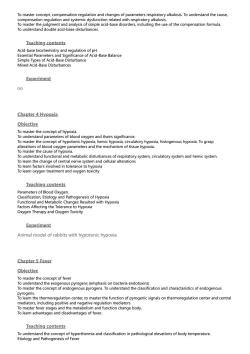
To master concept, ompensation regulation and changes of parameters respiratory alkalosis.To understand the cause, To understand double acid-base disturbances. Teaching contents Ad-basetbochenna0lre2ChieoiA20BaseBalance -Base Disturbances Experiment Chapter 4 Hypoxia Objective To master the hy and theirs significance xia,circulatory hypoxia,histogenous hypoxia.To grasp change of ce To learn oxygen treatment and oxygen toxicity Teaching contents Parameters of Blood Oxygen Hypoxia Experiment Animal model of rabbits with hypotonic hypoxia Chapter 5 Fever Objective omaster the ncept of fever mediators,including positiv and n T8Ieatedana2geandvametaboisnand Teaching contents To understand the concept of hyperthermia and classification in pathological elevations of body temperature. Etiology and Pathogenesis of Feve
To master concept, compensation regulation and changes of parameters respiratory alkalosis. To understand the cause, compensation regulation and systemic dysfunction related with respiratory alkalosis. To master the judgment and analysis of simple acid-base disorders, including the use of the compensation formula. To understand double acid-base disturbances. Teaching contents Acid-base biochemistry and regulation of pH. Essential Parameters and Significance of Acid-Base Balance Simple Types of Acid-Base Disturbance Mixed Acid-Base Disturbances Experiment no Chapter 4 Hypoxia Objective To master the concept of hypoxia. To understand parameters of blood oxygen and theirs significance. To master the concept of hypotonic hypoxia, hemic hypoxia, circulatory hypoxia, histogenous hypoxia. To grasp alterations of blood oxygen parameters and the mechanism of tissue hypoxia. To master the cause of hypoxia. To understand functional and metabolic disturbances of respiratory system, circulatory system and hemic system. To learn the change of central nerve system and cellular alterations To learn factors involved in tolerance to hypoxia To learn oxygen treatment and oxygen toxicity Teaching contents Parameters of Blood Oxygen. Classification, Etiology and Pathogenesis of Hypoxia Functional and Metabolic Changes Resulted with Hypoxia Factors Affecting the Tolerance to Hypoxia Oxygen Therapy and Oxygen Toxicity Experiment Animal model of rabbits with hypotonic hypoxia Chapter 5 Fever Objective To master the concept of fever To understand the exogenous pyrogens (emphasis on bacteria endotoxins) To master the concept of endogenous pyrogens. To understand the classification and characteristics of endogenous pyrogens. To learn the thermoregulation center, to master the function of pyrogenic signals on thermoregulation center and central mediators, including positive and negative regulation mediators To master fever stages and the metabolism and function change body. To learn advantages and disadvantages of fever. Teaching contents To understand the concept of hyperthermia and classification in pathological elevations of body temperature. Etiology and Pathogenesis of Fever
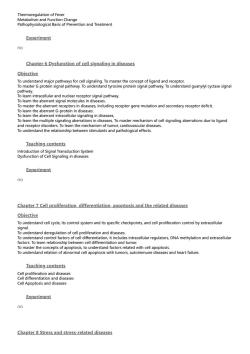
of Fever Pathophysiological Basis of Prevention and Treatment Experiment no Chapter 6 Dysfunction of cell signaling in diseases Objective To understand major pathways for cell signaling.To master the concept of ligand and receptor. TBmaerGproteinsigndlpsthway.Tounderstandtrosineprotensignalpathway.ToundestandguanytMgyclases5gnal Tolea intracellular and nuclear receptor signal pathway. diseases receptor gene mutation and secondary receptor deficit 8l伦amh8beTantGprotenndse inin disease To learn the multiple signaling aberrations in diseases.To master mechanism of cell signaling aberrations due to ligand aodreeptordioeiet n th Teaching contents Experiment no Chapter 7 Cellproliferation,differentiation.apoptosis and the related diseases Objective To understand cell cycle,its control system and its specific checkpoints,and cell proliferation control by extracellular signal tors of cell diffe 一aaencaapgeoesaonnaormaaaonehe Teaching contents Ceameeratandaees CelApOpiossnaneeases Experiment no Chapter 8 Stress and stress-related diseases
Thermoregulation of Fever Metabolism and Function Change Pathophysiological Basis of Prevention and Treatment Experiment no Chapter 6 Dysfunction of cell signaling in diseases Objective To understand major pathways for cell signaling. To master the concept of ligand and receptor. To master G protein signal pathway. To understand tyrosine protein signal pathway. To understand guanylyl cyclase signal pathway. To learn intracellular and nuclear receptor signal pathway. To learn the aberrant signal molecules in diseases. To master the aberrant receptors in diseases, including receptor gene mutation and secondary receptor deficit. To learn the aberrant G-protein in diseases. To learn the aberrant intracellular signaling in diseases, To learn the multiple signaling aberrations in diseases. To master mechanism of cell signaling aberrations due to ligand and receptor disorders. To learn the mechanism of tumor, cardiovascular diseases. To understand the relationship between stimulants and pathological effects. Teaching contents Introduction of Signal Transduction System Dysfunction of Cell Signaling in diseases Experiment no Chapter 7 Cell proliferation, differentiation, apoptosis and the related diseases Objective To understand cell cycle, its control system and its specific checkpoints, and cell proliferation control by extracellular signal. To understand deregulation of cell proliferation and diseases. To understand control factors of cell differentiation, it includes intracellular regulators, DNA methylation and extracellular factors. To learn relationship between cell differentiation and tumor. To master the concepts of apoptosis, to understand factors related with cell apoptosis. To understand relation of abnormal cell apoptosis with tumors, autoimmune diseases and heart failure. Teaching contents Cell proliferation and diseases Cell differentiation and diseases Cell Apoptosis and diseases Experiment no Chapter 8 Stress and stress-related diseases

Objective To master the concept of stress know the clas cation of stre al adaptation s To understand ephrine neurons sympathetic adrenal med sources of AP I8eamermt9lgplnafthentckpngegafaStis2oehebastcomponensandbastcuncdionofHsrs ances,gonadal。 Teaching contents enehrepondofsres nses of Body Experiment Animal model of stress diseases and discuss the mechanism of stress diseases Chapter 9 Coagulation-anticoagulation balance and imbalance of haemostatic system Objective To master mechanism of DIC know the causes of DI antbpesO0eorstoDg To master m chanisn To learn dysfunction of multiple organs Teaching contents Etiology and Mechanism of DIC niand Metablic Changeof DI E赵periment no Chapter 10 Shock Objective To master the concept of shock and to learn the history of shock lo understand the classification of shock. hcaocieubiondscerioUnderstana1hecompeneaiaegnicanceofmicoeraulaahangesoieamcinical manifestation
Objective To master the concept of stress know the classification of stressor To understand the concept, stages and manifestations of general adaptation syndrome To understand neuroendocrine responses to stress (mainly the locus ceruleus norepinephrine neurons sympathetic / adrenal medulla axis, hypothalamus pituitary adrenal cortex axis and hormones). To learn other endocrine responses. To master the concept of acute phase protein (AP). To understand biological function of AP, to learn the components and sources of AP. To master the concept of heat shock protein (HSPs). To learn the basic components and basic function of HSPs. To learn metabolism and function changes of stress onto body. To master the concept and mechanism of stress ulcer, to learn the relation of stress with cardiovascular disturbances, endocrine disturbances, gonadal axis disturbance, psychosocial disturbance. Teaching contents Introduction General Respond of Stress Cellular and Humoral Responses Functional and Metabolic Responses of Body Stress -related Diseases Experiment Animal model of stress diseases and discuss the mechanism of stress diseases Chapter 9 Coagulation-anticoagulation balance and imbalance of haemostatic system Objective To master mechanism of DIC know the causes of DIC To understand predisposing factors to DIC To learn stages and types of DIC To master mechanism of bleeding of DIC (especially FDPs). To understand mechanism of shock and anemia To learn dysfunction of multiple organs Teaching contents Etiology and Mechanism of DIC Predisposing Factors to DIC Stages and Types of DIC Functional and Metabolic Changes of DIC Experiment no Chapter 10 Shock Objective To master the concept of shock and to learn the history of shock To understand the classification of shock. To master the change of microcirculation and tissue blood volume in ischemic anoxia stage, the mechanism of microcirculation disorders. To understand the compensative significance of microcirculation changes. To learn clinical manifestation
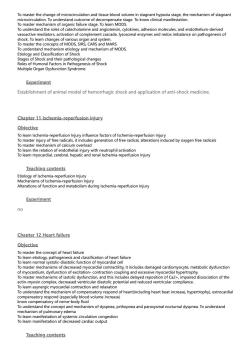
omastth hang fthe meha of snant I0mastermechani5moto9anicaileg6T81emdgaoe mechanism etiology and mechanism of MODS. Etiology and Classifi ation of Shock oles of Humoral Factors in Pathogenesis of shock Multiple Organ Dysfunction Syndrome Experiment Establishment of animal model of hemorrhagic shock and application of anti-shock medicine Chapter 11 Ischemia-reperfusion ipjury. Objective To learn Ischemia-reperfusion Injury influence factors of Ischemia-reperfusion Injury free alterations induced byy free radicals 8moacp Teaching contents Alterations of function and metabolism during Ischemia-reperfusion Injury E赵periment Chapter 12 Heart failure To master the concept of heart failure To master mech sms of dec of of the actin-myosin complex,de entricular diastolic potential and reduced ventricular compliance. of heart(heart beat increase hypertrohy)xtrocardia compensatory respond (bl d volume increase) To understand the concept and mechanism of dyspnea,prthopnea and paroxysmal noctumal dyspnea.To understand nechanism of pulmonary edema ioleammanestat6n6fa8easgCarcacpleston Teaching contents
To master the change of microcirculation and tissue blood volume in stagnant hypoxia stage, the mechanism of stagnant microcirculation. To understand outcome of decompensate stage. To know clinical manifestation. To master mechanism of organic failure stage. To learn MODS. To understand the roles of catecholamine and angiotensin, cytokines, adhesion molecules, and endothelium-derived vasoactive mediators, activation of complement cascade, lysosomal enzymes and redox imbalance on pathogenesis of shock. To learn changes of various organ and system. To master the concepts of MODS, SIRS, CARS and MARS To understand mechanism etiology and mechanism of MODS. Etiology and Classification of Shock Stages of Shock and their pathological changes Roles of Humoral Factors in Pathogenesis of Shock Multiple Organ Dysfunction Syndrome Experiment Establishment of animal model of hemorrhagic shock and application of anti-shock medicine. Chapter 11 Ischemia-reperfusion injury Objective To learn Ischemia-reperfusion Injury influence factors of Ischemia-reperfusion Injury To master injury of free radicals, it includes generation of free radical, alterations induced by oxygen free radicals To master mechanism of calcium overload To learn the relation of endothelial injury with neutrophil activation To learn myocardial, cerebral, hepatic and renal Ischemia-reperfusion Injury Teaching contents Etiology of Ischemia-reperfusion Injury Mechanisms of Ischemia-reperfusion Injury Alterations of function and metabolism during Ischemia-reperfusion Injury Experiment no Chapter 12 Heart failure Objective To master the concept of heart failure To learn etiology, pathogenesis and classification of heart failure To learn normal systolic-diastolic function of myocardial cell To master mechanisms of decreased myocardial contractility, it includes damaged cardiomyocyte, metabolic dysfunction of myocardium, dysfunction of excitation- contraction coupling and excessive myocardial hypertrophy. To master mechanisms of iastolic dysfunction, and this includes delayed reposition of Ca2+, impaired dissociation of the actin-myosin complex, decreased ventricular diastolic potential and reduced ventricular compliance. To learn asynergic myocardial contraction and relaxation To understand the mechanism of compensatory respond of heart(including heart beat increase, hypertrophy), extrocardial compensatory respond (especially blood volume increase) know compensatory of nerve-body fluid To understand the concept and mechanism of dyspnea, prthopnea and paroxysmal nocturnal dyspnea. To understand mechanism of pulmonary edema To learn manifestation of systemic circulation congestion To learn manifestation of decreased cardiac output Teaching contents
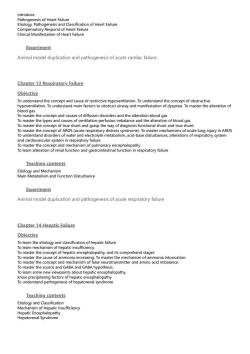
Introduce Experiment Animal model duplication and pathogenesis of acute cardiac failure. Chapter 13 Respiratory Failure Objective od gas omaster the and grasp the way of diagnosis functional shunt and true shunt. ARDS Tounderstand disordersof water and electrolyte metabolismacid-base of and cardi wascular system in respiratory failure T8IeameteaongPteifnct8nana2gtotesnalfPeiorn7espiatoyfailure Teaching contents etabolism and Function Disturbance E赵periment Animal model duplication and pathogenesis of acute respiratory failure Chapter 14 Hepatic Failure Objective To lea the etiology and cla of hepatic failure To master the concept of hepatic encephalopathy,and its comprehend stages To master the cause To master the source and GABA and GABA hypothesis. o learn some ne To understand pathogenesis of hepatorenal syndrome Teaching contents Etiology and Classification ufficiency Hepatorenal Syndrome
Introduce Pathogenesis of Heart Failure Etiology, Pathogenesis and Classification of Heart Failure Compensatory Respond of Heart Failure Clinical Manifestation of Heart Failure Experiment Animal model duplication and pathogenesis of acute cardiac failure. Chapter 13 Respiratory Failure Objective To understand the concept and cause of restrictive hypoventilation. To understand the concept of obstructive hypoventilation. To understand main factors to obstruct airway and manifestation of dyspnea. To master the alteration of blood gas To master the concept and causes of diffusion disorders and the alteration blood gas To master the types and causes of ventilation-perfusion imbalance and the alteration of blood gas To master the concept of true shunt and grasp the way of diagnosis functional shunt and true shunt. To master the concept of ARDS (acute respiratory distress syndrome). To master mechanisms of acute lung injury in ARDS To understand disorders of water and electrolyte metabolism, acid-base disturbances, alterations of respiratory system and cardiovascular system in respiratory failure To master the concept and mechanism of pulmonary encephalopathy To learn alteration of renal function and gastrointestinal function in respiratory failure Teaching contents Etiology and Mechanism Main Metabolism and Function Disturbance Experiment Animal model duplication and pathogenesis of acute respiratory failure Chapter 14 Hepatic Failure Objective To learn the etiology and classification of hepatic failure To learn mechanism of hepatic insufficiency To master the concept of hepatic encephalopathy, and its comprehend stages To master the cause of ammonia increasing. To master the mechanism of ammonia intoxication. To master the concept and mechanism of false neurotransmitter and amino acid imbalance. To master the source and GABA and GABA hypothesis. To learn some new viewpoints about hepatic encephalopathy. know precipitating factors of hepatic encephalopathy To understand pathogenesis of hepatorenal syndrome Teaching contents Etiology and Classification Mechanism of Hepatic Insufficiency Hepatic Encephalopathy Hepatorenal Syndrome

Experiment no Chapter 15 Renal Failure To understand dysfunction of glomerular filtration.this includes decrease of renal blood flow.glomerular effective and the distal convoluted tubules and collecting ducts. IB0ndetandrenalendocinedystancion,thisinctudesactnvationofrenin-angiotensinaldosteronesystemdecreased To master the concept of acute renal failure arn caus mechanism of liguria phas ,hyperkalemia in. To learn meck isms of renal cell injury To lea the process and mecha ism of chronic renal failure mechanism of renal h n renal ar mia, dopy abolism dysfunction and metabolic o learn th e man ation of ur al dysfunction in chron ren. l failu hemorrhagic tendency Teaching contents Taches for Renal Failure Chronic Renal Failure Uremia Experiment no Chapter 16 Brain Dysfunction Objective Tolea structural basisof To leamn etiology and pathogenesis of chronic brain damage Teaching contents
Experiment no Chapter 15 Renal Failure Objective To understand dysfunction of glomerular filtration, this includes decrease of renal blood flow, glomerular effective filtration pressure, glomerular capillary surface area and alterations of permeability of glomerular filtration member. To understand renal tubular dysfunction, and this includes dysfunction of the proximal convoluted tubules, henle’s loop, and the distal convoluted tubules and collecting ducts. To understand renal endocrine dysfunction, this includes activation of rennin- angiotensin aldosterone system, decreased EPO and etc. To master the concept of acute renal failure To learn cause and types of acute renal failure To understand the process of oliguric acute renal failure (initial phase, oliguria phase, diuresis phase). To understand mechanism of oliguria phase. To master mechanism of initial phase. To understand the cause of azotemia, metabolic acidosis, hyperkalemia in initial phase. To learn mechanisms of renal cell injury To understand the concept of chronic renal failure To learn the cause of chronic renal failure To learn the process and mechanism of chronic renal failure To master the concept of azotemia, mechanism of phosphate and calcium metabolism dysfunction and metabolic acidosis, mechanism of renal hypertension, renal anemia, renal osteodystrophy To learn the manifestation of urinal dysfunction in chronic renal failure To learn disorders of sodium metabolism, potassium metabolism, and hemorrhagic tendency To master the concept of uremia To learn alteration of function and metabolism and mechanism of uremia Teaching contents Basic Pathological Taches for Renal Failure Acute Renal Failure Chronic Renal Failure Uremia Experiment no Chapter 16 Brain Dysfunction Objective To learn structural basis of cognition To understand major manifestation of cognitive disorders To learn etiology and pathogenesis of chronic brain damage To master the concept of consciousness disorder and its etiology and pathogenesis To understand systemic disturbance caused by consciousness disorder Teaching contents Cognitive disorders Consciousness disorder
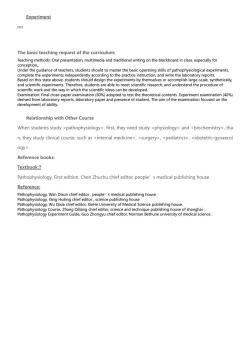
Experiment no The basic teaching request of the curriculum: Teaching methods:Oral presentation,multimedia and traditional writingon the blackboard in class.especially for scienific workand the way in which the ideas can be developed. development of ability. Relationship with Other Course When students study ,first,they need study and ,tha n,they study clinical course,such as ,,,. Reference books: Textbook:? Pathophysiology,First edition,Chen Zhuchu chief editor,people's medical publishing house Reference: XiHe University of Medica Science publishing house
Experiment no The basic teaching request of the curriculum: Teaching methods: Oral presentation, multimedia and traditional writing on the blackboard in class. especially for conception。 Under the guidance of teachers, students should to master the basic operating skills of pathophysiological experiments, complete the experiments independently according to the practice instruction, and write the laboratory reports. Based on this state above, students should design the experiments by themselves or accomplish large-scale, synthetically, and scientific experiments. Therefore, students are able to meet scientific research, and understand the procedure of scientific work and the way in which the scientific ideas can be developed. Examination: Final close-paper examination (60%) adopted to test the theoretical contents. Experiment examination (40%) derived from laboratory reports, laboratory paper and presence of student. The aim of the examination focused on the development of ability. Relationship with Other Course When students study , first, they need study and , tha n, they study clinical course, such as , , , . Reference books: Textbook:? Pathophysiology, First edition, Chen Zhuchu chief editor, people’s medical publishing house Reference: Pathophysiology, Wan Dixun chief editor , people’s medical publishing house Pathophysiology, Yang Huiling chief editor , science publishing house Pathophysiology, Wu Qixia chief editor, XieHe University of Medical Science publishing house. Pathophysiology Course, Zhang Qiliang chief editor, science and technique publishing house of shanghai Pathophysiology Experiment Guide, Guo Zhongyu chief editor, Norman Bethune university of medical science
按次数下载不扣除下载券;
注册用户24小时内重复下载只扣除一次;
顺序:VIP每日次数-->可用次数-->下载券;
- 上海市肿瘤研究所:肿瘤问题(PPT讲稿)肿瘤分子生物学前沿的若干问题.ppt
- 南京医科大学:生物芯片技术及其应用(PPT课件讲稿,主讲:童明庆).ppt
- 《医学免疫学》课程PPT教学课件(讲稿)形态学研究及其方法进展.ppt
- 牡丹江医学院:《病原生物学》课程PPT教学课件(讲稿)医学免疫学实验.ppt
- 《生物化学》课程教学资源(文献资料)新冠病毒奥密克戎(Omicron, B.1.1.529)变异株对我市影响的风险评估及防控建议.pdf
- 南方医科大学:《生物化学》课程教学资源(教学案例)地中海贫血.docx
- 《生物化学》课程教学资源(教学案例)新冠肺炎.docx
- 《生物化学》课程教学资源(文献资料)新冠病毒——病例分析.pdf
- 《生物化学》课程教学资源(文献资料)非小细胞肺癌和EGFR.pdf
- 南方医科大学:《生物化学》课程教学资源(PPT课件讲稿)基因编辑技术.pptx
- 南方医科大学:《生物化学》课程教学资源(PPT课件讲稿)基因治疗(主讲:宋艳斌).ppt
- 《生物化学》课程教学资源(讲义)三种基因编辑工具的比较.docx
- 南方医科大学:《生物化学》课程教学资源(讲义)非小细胞肺癌的靶向药物治疗.docx
- 南方医科大学:《生物化学》课程教学资源(讲义)液态活检.docx
- 南方医科大学:《生物化学》课程教学资源(PPT课件讲稿)基因诊断 Gene Diagnosis.ppt
- 南方医科大学:《生物化学》课程教学资源(PPT课件讲稿)基因与疾病的关系 GENE AND DISEASE.ppt
- 南方医科大学:《生物化学》课程教学资源(PPT课件讲稿)癌基因与抑癌基因 Oncogenes, Tumor suppressor gene.ppt
- 南方医科大学:《生物化学》课程教学资源(PPT课件讲稿)DNA重组与重组DNA技术.pptx
- 《生物化学》课程教学资源(文献资料)常用分子生物学技术——主要基因检测方法原理及优缺点.docx
- 《生物化学》课程教学资源(文献资料)聚焦肠道菌群与免疫代谢的互作(The Gut Microbiota at the Service of Immunometabolism).pdf
- 山东第一医科大学(泰山医学院):《医学免疫学》课程教学资源(授课教案)医学微生物学理论教案.doc
- 山东第一医科大学(泰山医学院):《医学免疫学》课程教学资源(授课教案)医学微生物实验教案.doc
- 山东第一医科大学(泰山医学院):《病理学》课程教学大纲(负责人:王学春).pdf
- 山东第一医科大学(泰山医学院):《病理学》课程授课教案(主讲:黄庆玉).doc
- 山东第一医科大学(泰山医学院):《病理学》课程实习指导(讲义,共十五个).docx
- 山东第一医科大学(泰山医学院):《病理学》课程学习要点与作业习题(无答案).pdf
- 山东第一医科大学(泰山医学院):《病理学》课程疑难解析.pdf
- 山东第一医科大学(泰山医学院):《病理学》课程教学课件(PPT讲稿)第1章 绪论 pathology、细胞和组织的适应与损伤(主讲:孙文平).ppt
- 山东第一医科大学(泰山医学院):《病理学》课程教学课件(PPT讲稿)第2章 损伤的修复.ppt
- 山东第一医科大学(泰山医学院):《病理学》课程教学课件(PPT讲稿)第3章 局部血液循环障碍.ppt
- 山东第一医科大学(泰山医学院):《病理学》课程教学课件(PPT讲稿)第4章 炎症 inflammation.ppt
- 山东第一医科大学(泰山医学院):《病理学》课程教学课件(PPT讲稿)第5章 肿瘤(一).ppt
- 山东第一医科大学(泰山医学院):《病理学》课程教学课件(PPT讲稿)第5章 肿瘤(二).ppt
- 山东第一医科大学(泰山医学院):《病理学》课程教学课件(PPT讲稿)第6章 心血管系统疾病.ppt
- 山东第一医科大学(泰山医学院):《病理学》课程教学课件(PPT讲稿)第7章 呼吸系统疾病.ppt
- 山东第一医科大学(泰山医学院):《病理学》课程教学课件(PPT讲稿)第8章 消化系统疾病(一).ppt
- 山东第一医科大学(泰山医学院):《病理学》课程教学课件(PPT讲稿)第8章 消化系统疾病(二).ppt
- 山东第一医科大学(泰山医学院):《病理生理学》课程教学大纲(临床医学本科专业).pdf
- 山东第一医科大学(泰山医学院):《病理生理学》课程实验指导(负责人:商战平).pdf
- 《病理生理学》课程教学资源(作业习题)病理生理学复习题及答案.pdf
